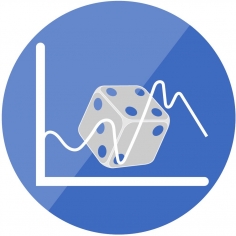
Data and Chance
You meet a new friend at CTY who teaches you a dice game. The rules are simple: if you roll a 4, you win and the game ends. If your friend rolls a 5, she wins and the game ends. You take turns rolling until one person wins. If you roll first, what is the probability that you will win the game? There are several ways to solve this problem, and the answer is not obvious.
In this course, students develop a greater understanding of probability and statistics, two areas of mathematics that easily transfer from the classroom to the real world. Students conduct experiments and generate data which they display in graphs, charts, and tables in order to compare the effects of particular variables. For example, students might analyze data to examine how various design characteristics of a paper airplane, such as weight or length, affect the distance it will travel. In addition, students consider other data sources, including newspapers and journals, and identify examples of incorrectly gathered or misrepresented data that have been used to mislead consumers or influence voters.
Students also explore probability, the study of chance, to learn how to use numerical data to predict future events. Students examine permutations and combinations; develop strategies for calculating the number of possible outcomes for various events; calculate probabilities of independent, dependent, and compound events; and learn to distinguish between theoretical and experimental probability.
